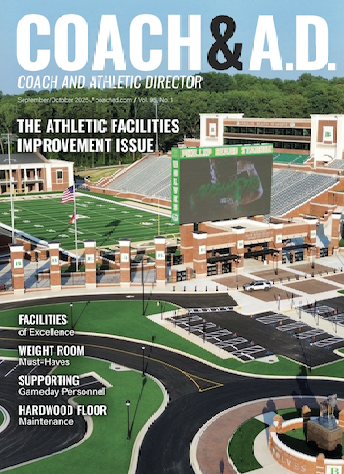Game Planning Your Defensive Coverages
Probably the most vital decision you will have to make in your game planning is what kind of key coverages to use. Most of them will fit into one of the four basic types: zone, man to man, combination, or blitz.
We realize that most defenses will use all or part of each package and that every defense will usually be more proficient than the others in one area. Allow us to highlight the advantages and disadvantages of each system and to include a compendium of offensive thought on how to attack each of the specific defensive schemes.
Advantages of Zone Defenses:- Defends the field.
- Makes the ball the issue.
- Offers better run support than man coverages.
- Gives all the defenders a better view of the ball and allows them to break when the ball is thrown.
- May give up completions, but not deep completions. It’s hard to blow the top off the coverage.
- Makes the offense go the long way and forces the offense to execute.
- Produces more interceptions than man coverage does because all defenders see and rally to the ball.
- Provides better gang-tackling than man.
- Requires less talented players.
- Handles crossing routes, picks, and rub-offs better than man coverage. Receivers can be punished on short crossing routes.
Disadvantages of Zone Defense:
- Defense must get pressure with a base rush.
- Quarterback has time to throw and can get into rhythm.
- Allows a high completion rate.
- Pass-protection schemes allow help to be given to weak blockers.
- Zones can be flooded.
Offensive Plan of Attack Against Zones:
- Horizontally stretches the defense to attack seams between defenders.
- Places stress on the defense with a high-low or in-out philosophy. Makes the defense fashion a decision and then takes advantage of that decision.
- Attacks horizontally between intermediate and deep coverage (vertical stretch).
- Places receivers underneath intermediate area defenders who drop quickly to cover the horizontal horizon. The quarterback will work deep to intermediate to short.
- Attacks inferior defenders. Zone responsibilities usually place these men in predictable areas or positions.
- Screen passes become more effective as underneath coverage gets more depth.
- Throw to a back after faking a run to him.
- Clear an area with a second receiver who follows a clearing route.
Advantages of Man Coverage:
- Doesn’t defend grass.
- The ball is the issue.
- Completion rate is lower.
- Defense can use numbers to attack protection schemes.
- Various games and stunts are available.
- Added number of rushers pressures the quarterback. The results are hurried passes and sacks.
- Quarterback may have to hold the ball longer waiting for the receiver to break free. Makes the quarterback pass the ball.
- With tighter coverage the quarterback must be more accurate. He has to “stick the ball in there.”
- Man coverage is better in short and medium down and distance situations.
- A linebacker can insert or drop to find work if his assignment blocks.
- Insertion of a linebacker when his man blocks will disrupt screens.
Disadvantages of Man Coverage:
- Needs more athletic personnel.
- Completions usually mean longer gains.
- Interceptions are less likely because more defenders will have their back to the ball.
- Defenders can be isolated. Mismatches can occur.
- Scrambling quarterbacks are a problem to underneath defenders. These men usually have their backs to the ball.
- Coverage busts are more costly than zone. There is usually no one to cover up in man coverage.
- Offenses can use play action to present a conflict between run/pass responsibilities.
- Mismatches are possible, especially with formation changes or motion.
- The defense must get to the quarterback with pressure or defenders will be hung out.
- The strong safety may give away the coverage by his alignment on the tight end.
- Underthrown deep route is harder to play in man.
- Offensive Plan of Attack Against Man Coverage:
- Scheme mismatches through use of formations, shifts, or motions.
- Pick or rub defenders with crossing routes.
- Pressure underneath defenders and force players with play action passes.
- Pass to a back after the back has faked a run.
Underneath Coverage:
A major component in your game plan is how to play underneath coverage against your opponent’s passing game. How you play your linebackers is crucial to successfully thwarting your opponent’s passing game. Some pertinent questions to ask include:
- How effective will the linebackers be in defending the pass game? Will they have to be replaced with a nickel or dime package on passing downs or are they competent enough to get the job done?
- How do they match up with the opponent’s running backs? Can they cover the backs one on one?
- Will offensive formations necessitate banjo (in-out) coverage?
- Do you run linebackers through versus sprint passes? If so, whom do you send? Is it better to send the front side or back-side linebacker to pressure the quarterback?
- Do you need to assign a linebacker spy responsibilities against a mobile quarterback?
- Versus a good receiving back, do you stunt a linebacker in his area to keep him from releasing? If the back is placed over a linebacker who rarely stunts, he will check release into the route. You must be flexible and place your best blitzer to his side to keep him from releasing.
- Do you green dog or hug a running back if he pass blocks? In man to man coverage it is best to have your linebacker assigned to him go get him if the offense likes to screen. Green dogging also keeps a back from checking down. If the offense is known for running a lot of crossing routes, it might be best to drop a linebacker if his assignment pass blocks. This places him in position to disrupt those crossing routes.


